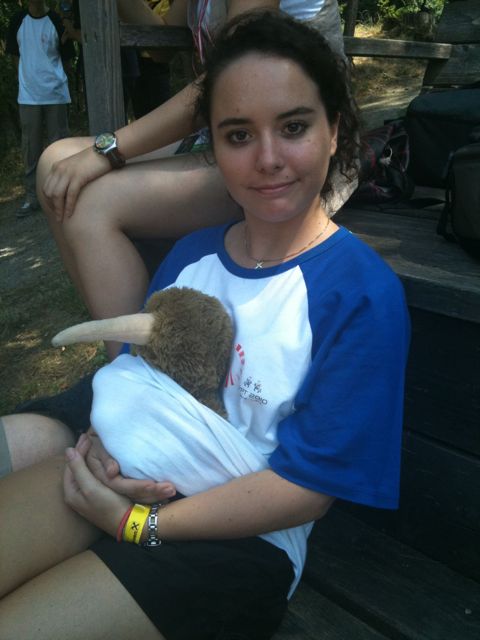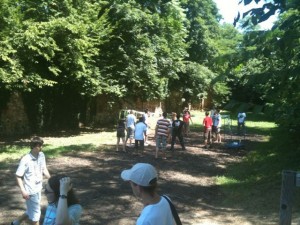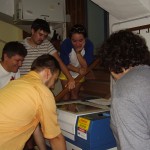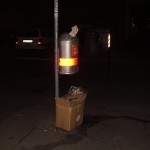The final of the 23rd IYPT has just started. President Allinson in introducing the jurors right now. I will continue updating this blog post so you can get some real time info from the final.
Now the team from Singapore has started their report on Problem 14: Magnetic Spring.
The “Kuppelsaal” of the TU Vienna is pretty full, about 300 people are watching the final.
I am uploading some pictures from day 3 to the gallery now. Pictures from our trip to Melk and from the finals will be added later.
Opponent Bernhard Zatloukal is asking about eddy currents, longer magnets and the motion equation and possible errors. Is it possible to model this with a spring constant? What’s the torque on the magnet? What’s the force on the magnets?
President Allinson is asking the audience for some silence while the team of Austria prepares their Opponence. Obviously there’s a lot to talk about 🙂
A very vivid discussion. The Opponent tries to find flaws with the reporter’s work. However the team from Singapore shows solid work and the reporter is very well prepared.
Bernhard points that the model used is only an approximation. Both agree. In general there does not seem to be much, that the two teams do not agree on, both seam to have a very good understanding of the problem.
Korea, the Reviewer in this stage, is now asking questions to both the Reporter and the Opponent.
We now are hearing some questions from the jury.
The grading of stage 1 (in no way official, this is just to give you an impression on how the teams are doing. and to stress this once again: this marks are not official at all)
Reporter: 10 9 9 9 8 9 10 10 9 9
Opponent: 9 9 8 8 8 8 7 8 8 8
Reviewer: 8 9 8 8 7 8 9 8 9 8
Andrii Lazariev explains his rather low grading (8, 8, 7) – he wants to point out that doesn’t vote higher just because it’s the finals.
Samuel Byland explains the 7 for the Opponent: The Opponent at times seamed overwhelmed by the reporter’s vast knowledge.
Yung-Yuan Hsu explains his 10 to for the reporter: Everything was logical.
I just double checked the marks with our fight assistant Andreas. Still don’t consider anything official until I put it on our website iypt.at 🙂
Stage 2
The break is over and the Team of Austria is preparing their experiment.
Michael Scherbela is giving his Report on Problem 1 Electromagnetic cannon.
After about 9 minutes Michael shows us the experiment which they built based on their theoretical considerations on what the perfect parameters for the cannon would be.
After 11 Minutes and 22 Seconds the report is over. Now we’re waiting for the opponent from Korea to prepare.
In the meantime I have updated the participants’ pictures in our gallery. It’s a dump from our database from some days ago – so this now includes everyone that we have a picture of. Sadly while the Australians’ mascot Schrödinger made it into our DB soon enough, Ernie Rutherford from the team of NZ was only added yesterday. Both now have an official IYPT2010 badge.
Now we see the Reporter and the Opponent doing live experiments. That’s true IYPT spirit!
We just heard the Reviewer’s questions and the volume in the audience is rising yet again. Waiting for the president so calm everyone down again 🙂
The reviewer wasn’t able to connect the projector in time. This happens a lot and is very frustrating – however most of the time it’s a software problem that we cannot do anything about.
Jennifer Randle of the team of NZ nevertheless does not seam to be nervous at all (though I am quite sure she is) despite any technical problems and presents a solid review.
Michael very passionately gives his concluding remarks: “I really kinda fell in love with this problem!” And once more fires the cannon.
Juror Valentin Lobyshev asks about increasing the capacitor, e.g. a few hundred times.
John Balcombe asks the Reporter what exactly he was trying to optimize: Velocity.
Martin Plesch asks about how theory and experiments fit together.
Samuel Byland wants to see the slides on the optimization again. Why was the length of the plunger kept constant?
ChuanYong Li asks for the maximum speed – about 10 m/s for the plunger.
Time is up, so heres the grading:
Reporter: 8 8 8 7 9 8 9 9 8 9
Opponent: 8 9 8 7 8 8 8 9 7 7
Reviewer: 8 9 8 7 7 7 8 8 7 7
(not official!!)
Valentin Lobyshev makes a comment: Problem is dynamic. You mixed everything. Dynamic and static. There is no dynamic for the piston. Nobody talked about it. If you increase the capacity plus 100 times – answer is absolutely wrong from everybody!
Martin Plesch disagrees with Valentin: I have a different view. If you adjust all parameters you get higher energy and therefore higher velocity. Martin only missed one thing and therefore didn’t give a 10: he would have liked the team to perform some experimental optimization around the theoretical maximum found.
Stage 3:
Dong Jin Ji from the team of Korea presents Problem 15 Paper anemometer.
Later we will hear New Zealand Teammember Tony Yuen as Opponent and Zi Yang Kang from Singapore as Reviewer.
They are using audio samples of their experiment. We could have used the room’s audio system line in. But no one asked… so now they hold the microphone close to their Laptop’s speaker.
Could someone brng me some food? I am getting hungry.
The Opponent asks about definitions. I still remember that from last year, it’s something the Kiwis always do 🙂 So: How do you define a fluid?
Tony has taken the stage, the projector works fine, we’ve changed the vga cable, just to make sure everything works now.
I’m about to add a picture of my view. Soon after the finals high quality pictures will be online. An in a few days or weeks we’ll have a movie by Peter Schatz who has been filming the Austrian team’s preparation, most of their fights, our trip to Melk yesterday and now the finals.
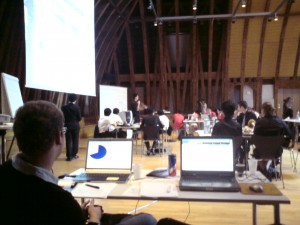
Tim's view of stage 3. On the left side we see Andi, the final's FA
Now Reporter and Opponent are working on their theories on the flip chart. Lots of talk about Reynold’s Numbers.
Tony now asks about humidity. The Reporter does not think, that this is an important parameter. (I’d like to also use the Reporter’s first name, but I heard somewhere that they use their names differently, and i dont want to upset anyone.)
Now Alan has to stop the discussion. We are waiting for the Reviewers questions.
It’s very refreshing that now teams (especially those in the finals) understand that the review isn’t just about telling the Reporter that his English was good and the presentation’s layout nicely done. It’s not the International Young Powerpoint-Users Tournament after all 😀
Wolfgang just brought something to eat. I’ll try to multitask 😀
Concluding remarks: The reporter points out why he thinks his model is correct.
Questions from the jury:
John Balcombe: Is the stiffness of the paper an important parameter?
Rep: some
Opp: yes
Rev: yes
Martin: What angle do you use, if the paper forms a wave.
Francisco Swaminathan: For what ranges is this correct, what happens outside the plotted range
Andrii Lazariev: lift force: what happens if we set alpha to 90°?
Answer: Stall. The given formula does not work in that case.
Reporter: 7 8 7 8 7 7 8 6 7 6
Opponent: 8 9 8 8 8 8 8 7 8 8
Reviewer: 9 9 8 8 8 9 8 9 10 9
(not official)
Martin Plesch explains his low grading: The theory was too simplified. A stiff body (which is used for the model) does not behave like paper.
Fabian Bühler: He agrees with Martin about the weak report. The Opponent didn’t address any of the reporter’s shortcomings.
Balcombe: He explains that he gave a 10 because the Reviewer did a good job identifying weaknesses. What more could they have done? Nothing – that’s why they got a 10 from John Balcombe.
The final stage of the IYPT2010 finals:
If the team of NZ had told us that they had special light requirements we would have been able to work something out. But hey, the IYPT is all about improvisation.
I think it’s fine now, and I am looking forward to some brilliant patterns.
The lighting is still constantly changing. Is this the lamps warming up or is someone playing with the light switch? Investigate 🙂
The report reminds me of the last year’s final: Optical Tube was also an optical problem reported by NZ.
If you are waiting for the official, final results: This will take some time. We have do double check everything, no one wants errors in the final results.
You can of course use the rules of the IYPT to calculate the results based on my (very unofficial just to stress that again) gradings i posted here.
Now it’s time for the last Opponent. And the audience is getting loud again. Alan?!
I think it’s kind of sad that out of the 20 finalists (4 teams with 5 members each) there is only one girl. A quick look in our DB tells me that about 30% of all participants (this includes jurors, volunteers and all teams) are female.
Only Austria included a live experiment. I really would have loved to see some more action on stage 🙂 And don’t say that that’s because the other teams had to travel so far: last year team Austria brought a little Experiment for almost every Problem. Even a Skateboard 🙂
Martin Schnedlitz who is doing the Review just finished asking his questions to the Reporter and the Opponent. It’s time for preparations of the Reviewer and the audience is getting loud again.
It’s time for the finals to be over, because the air conditioning can’t really keep up with all the people, lights and computers in this room any more.
Reporter’s concluding remarks are done and now we’ll again have some jury questions:
Andrii Lazariev to reporter: One laser was not ideal so we get rings. If the others were ideal – it is a narrow parallel beam, what is the difference if we change the laser’s position?
Valentin Lobyshev to opponent and reviewer: What information do you want to get from the diffraction?
Francisco Swaminathan to the reporter: What is the wavelength of the laser beams?
Martin Plesch: Which part of the picture is due to impurities?
Samuel Byland: Would you expect any other interference?
Grading:
Reporter: 7 8 8 9 7 7 7 8 8 7
Opponent: 7 9 8 7 8 8 8 8 8 8
Reviewer: 8 8 8 7 8 8 8 9 9 9
(not official)
Comments by the jurors:
Valentin: I liked this report and [???] from my point of view it doesn’t have mistakes [???] maybe it is not so [???] (I couldn’t understand some of what Valentin was saying. I think he liked the report.)
Martin: No mistakes, but some things missing.
Alan just ended this last fight of the IYPT2010. Thanks to all my blog readers!

